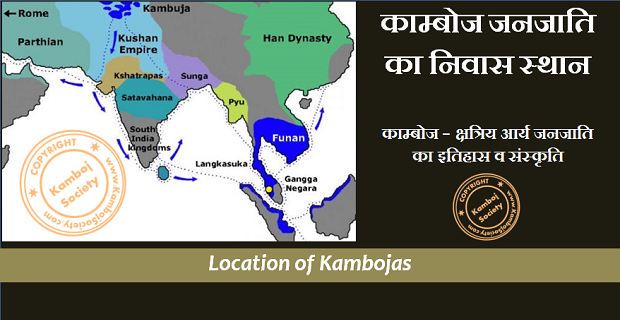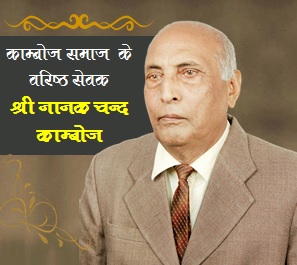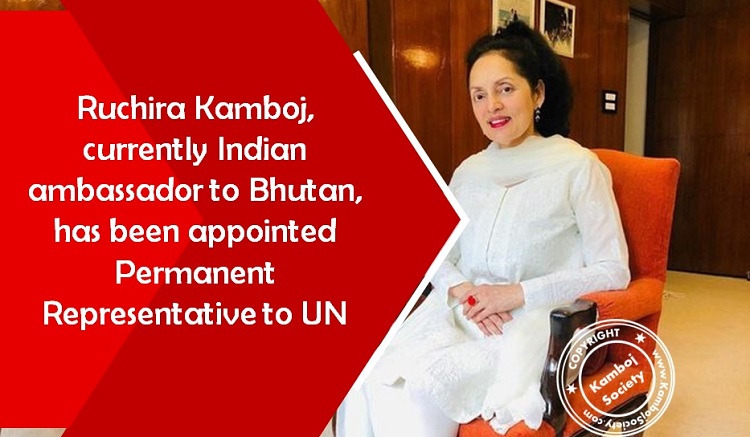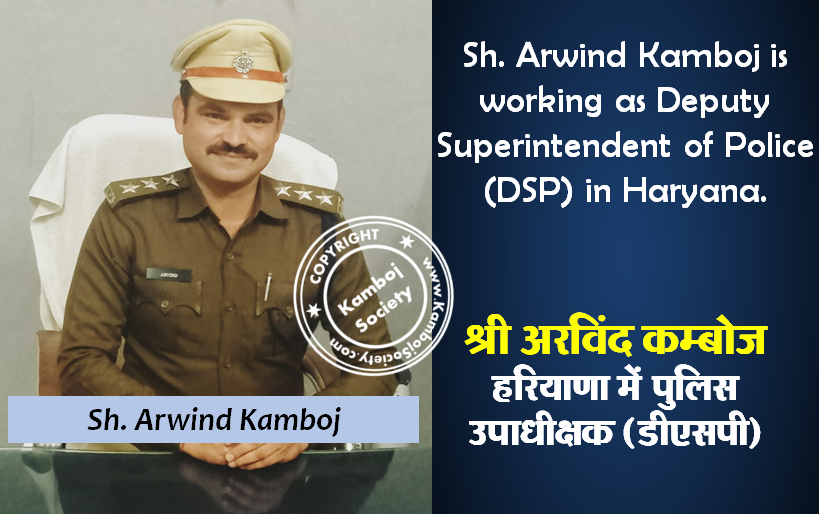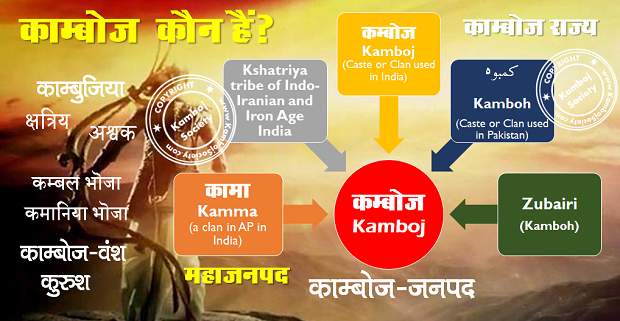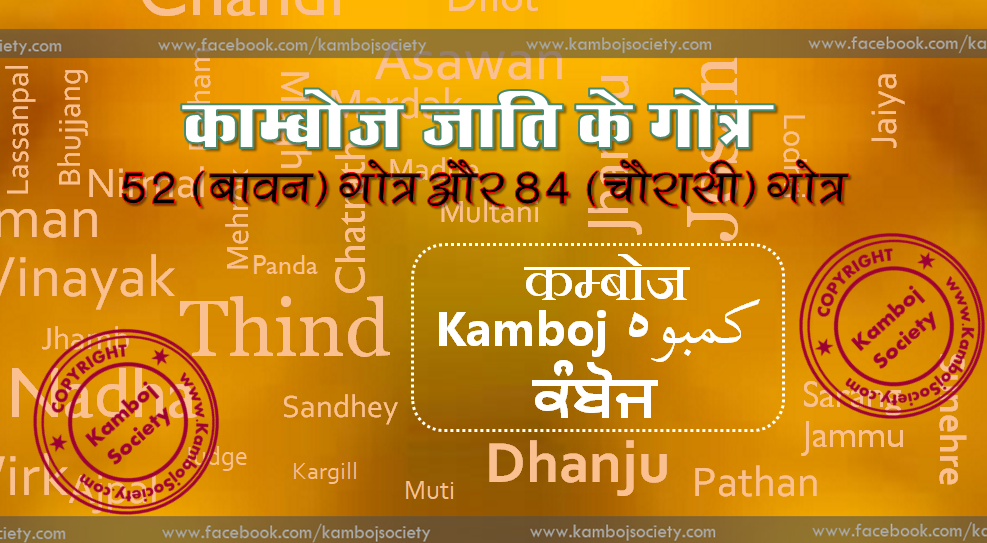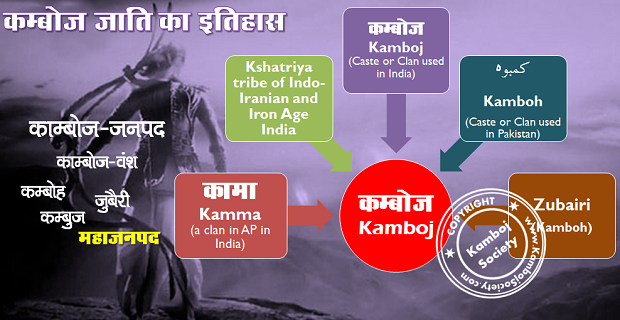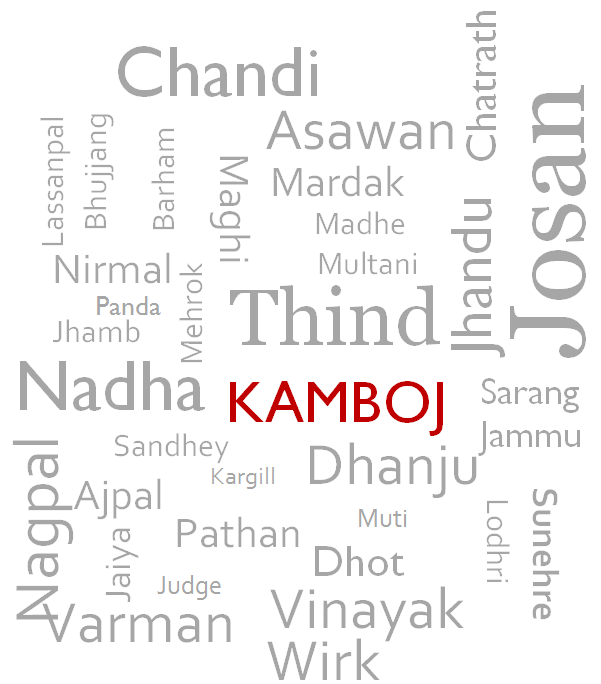Kamboja was the name of an ancient country and the Indo-Iranian warrior tribe settled therein. The country is listed as one of the sixteen Mahajanapadas or great nations in ancient Buddhist texts. The Kambojas are attested to have both Indian as well as Iranian affinities. There is no unanimosity on the location of Kamboja. Kamboja Location has been suggested in Khorasan, Balkh, Bokhara (Dr H. H. Wilson); Afghanistan (J. McCrindle); East Afghanistan (Dr Stein); Kafiristan to Kashmir (H. C. Raychaudhury, D. R. Bhandarkar); Pamir/Badakshan (Dr J. C. Vidyalankar, Raymond Allchin, Dr G. A. Grierson, Dr S. K. Chatterjee, Dr V. S. Aggarwala); Arachosia (D. C. Sircar, J. Fillozat, E. Benveniste, Michael Witzel); mountains of Ghazni (Willford); Sindh/Gujarat (Dr S. K. Aiyanger, Dr P. N. Banerjee); Hindukush/Tibet (Dr V. A. Smith); Tibet [Charles Elliot, Dr Foucher, Dr G. G. Gokhale) and Cambodia (R. D. Banerjee) with its capital at an unidentified place called Dvarka , a name with Maga Associations. Some scholars identify this Dvarka with the modern 'Darwaz city' located in Tajikstan in Central Asia.
Kambojas: a tribe of Uttarapatha
Epic evidence
It is important to note that in ancient literature and inscriptions, the Kambojas are mostly listed with the tribes of the Uttarapatha like the Gandharas, Bactria|Bahlikas, Yavanas, Madras, Sakas etc. Further at places in Mahabharata and Puranic literature, the Kambojas are specifically referred to as a tribe of Uttarapatha, Uttara or Udichya i.e north or north-west. e.g.
Sanskrit: Uttarashchapare mlechchha jana bharatasattama Yavanashcha sa Kamboja daruna mlechchha jatayah – (MBH 6/11/63-64)
Sanskrit:
Shakanam pahlavana.n cha daradanam cha ye nripah Kambojarishika ye cha pashchimanupakash cha ye – (MBH 5/5/15)Sanskrit: udichya kamboja shakaih khashaish cha – (MBH 5/159/20)
Puranic Bhuvankosa evidence
Bhuvanakosha section of numerous Puranas also specifically locates the Kambojas in the Udichya or north-west division of ancient India.
This numerous literary evidence indisputably proves that the Kamboja of ancient Sanskrit literature invariably refers to a tribe and country of that name located in the Uttarapatha or north division of ancient India. Therefore, the Kamboja of Sanskrit literature must not be confused with trans-Ganges|Gangetic Kamboja (or Kambuja) centered at Mekong drainage basin|basin which country came into existence several centuries after Christian era (Political History of Ancient India, 1996, p 133, Dr H. C. Raychaudhury, Dr B. N. Banerjee; Some Kashatriya Tribes, p 235, Dr Law).
It is to be noted that Cambodia or Kambuja/Kamboja of south-east Asia does not find any reference in ancient Sanskrit literature as is erroneously believed by some writers.
Localization of Kamboja
Linguistic evidence
The most acceptable view is that the ancient Kambojas originally belonged to the 'Galcha' speaking area (the Iranian Pamirs and Badakshan) in Central Asia (Linguistic Survey of India, Vol X, p 455, Dr G. A. Grierson).
Yaska's Nirukata (II/2.8) attests that verb 'shavati' in the sense 'to go' was used by the Kambojas and only the Kambojas (Early Eastern Iran and Atharvaveda, 1980, 92, Dr Michael Witzel; also Nilukata, Vol I, Sarup).
The modern Galcha language comprises seven main dialects viz. Valkhi, Shigali, Srikoli, Jebaka (also called Sanglichi or Ishkashim), Munjani, Yidga and Yagnobi.
It has been pointed out that the Galcha dialects spoken in Pamirs and countries on the head waters of Oxus mostly still have the continuants of the ancient Kamboja 'shavati' in the sense 'to go' (Linguistic Survey of India, Vol X, p 455-56,468,474,476,500, Dr G. A. Grierson).
Yagnobi dialect spoken in Yagnobi region at the head-waters of Zeravshan in the Doab of Oxus and Jaxartes in Tajikstan also contains, to this date, a relic from Kamboja verb 'shavati' in the sense 'to go' (Dr J. C. Vidyalankara, Proceedings and Transactions of 6th A.I.O. Conference, 1930, p 118 cf: op. cit. Vol X, pp 455-56, Dr G. A. Grierson).It has also been pointed out that the former language of Badakshan was a dialect of Galcha which has been replaced with Persian only in the last few centuries (Op cit, p 456, Dr Grierson).
Thus, originally, the ancient Kamboja appears to have comprised Pamirs, Badakshan and possibly parts of Tajikstan including Yagnobe region in the doab of Oxus of Central Asia. On the east it was bounded roughly by Yarkand and/or Kashgar, on west by Bahlika (Uttaramadra), on the northwest by Sogdiana, on the north by Uttarakuru, on the southeast by Darada and on the south by Gandhara.
Vamsa Brahmana and Aitareya Brahmana evidence
The Aupamanyava Kamboja of Vamsa Brahmana (1/18) is spoken of as pupil of sage Madrakara, who as his name itself indicates, belonged to the Madra tribe. Dr Zimmer as well as authors of Vedic Index postulate a close connection between the Iranian Uttramadras and the Kambojas . Both are stated to be close neighbors in the north-western part of ancient India (Vedic Index, I, p 84-85, 138).
Jean Przylusky shows that Bahlika (Balkh) was an Iranian settlement of the Madras who were known as Bahlika-Uttaramadras (The Udumbras, Journal Asiatique, 1926, p 11).
Madra king Salya of Mahabharata war has been referred to as a Bahlika Pungava i.e foremost among the Bahlikas (MBH I. 67.6; I.112.3). Princess Madri from Madra Royal family has also been referred to as Bahliki i.e princess from Bahlika (MBH I. 124. 21).
This shows that in remote past (Vedic age), Iranian settlement of the Madras, known as Uttaramadra was located in Bahlika (Bacteria) in eastern parts of the Oxus country. These Madras have been referred to as Uttaramadras in Aitareya Brahmana and are also stated to lie across the Himalaya i.e Hindukush (Aitareya Brahmana, VIII/14).
The Kambojas and Bahlikas (Bactrians) have been paired together (Kambojabahlika) in several verses of Mahabharata (7.98.13; 6.75.17; 2.27.23-23 etc). They also find mention as a pair in Valmiki Ramayana (I.6.22), Kshmendra's Ramayana-Manjri (4/252) as well as in Atharvaveda-Parisia (57.2.5; cf Persica-9, 1980, p 106, Dr Michael Witzel). This close association implies that the Bahlikas and the Kambojas shared borders with each other. Since Bahlikas were in Bactria, their close neighbors, the Kambojas, most likely occupied the eastern parts i.e. Badakshan/Pamirs of Oxus country.
Ptolemy's evidence
Ancient geographer Ptolemy calls the region fed by Jaxartes and its tributaries as Komdei (Sanskrit Kamudha). Ammianus Marcellinus calls it as Komadas. Ptolemy also refers to some tribal people he calls Komoi (=Kamoi) and Komroi and locates them in the mountainous regions of Sogdiana as far as Jaxartes. The Komoi of Ptolemy apparently represents Kamboi a variant of vulgo Kamboika, Kamboy, Kambo. Ashoka's Rock Edicts V and XII at Shahbazgarhi and the Jaina Canon Uttradhyana-Sutra (11/16), both write Kamboya for Kamboja.Komudha in Indian traditions is the name of mountainous region, north of mount Meru (Pamir). In the anterior Epic Age, this was the name given to high table land of the Tartary to north of Himalaya, from where the Aryans may have pushed their way southwards into Indian Peninsula and preserved the name as a relic of old mountain worship (Thomson).
Dr Buddha Parkash identifies the Ptolemy|Ptolemian Komdei with the Komudha-dvipa of the Puranic literature and connects it with the Iranian Kambojas (India and the World, p 71, Dr Buddha Parkash; also see Central Asiatic Provinces of Maurya Empire, p 403, Dr H. C. Seth).
This explains as to why the Yagnobi dialect of Yagnobe region in Zeravshan valley in Tajikstan still contains the relics of ancient verb 'shavti' of the Kamboji language.
Raghuvamsa's evidence
Raghuvamsa of Kalidasa (5th c AD) informs that after reducing the countries of western- Ghats, king Raghu proceeds via land-route to conquer the Parasikas (Raghu 4.60). The Parasikas loose the battle (Raghu 4.65). Raghu's forces move in north (kauberi ) direction from Parasika (Sassanian) land and hit Vamkshu (4.67). At Vamkshu, Raghu's horses take breather and shed off the Kesra (safron ) leaves from their shoulders by rolling in the sands of Vamkshu Banks (4.67). Here follows the encounter with the Hunas on west Banks of Vamkshu (Oxus) (4.68). The Hunas in 5th c AD were located in west parts of Oxus country i.e in Bactria. The Huna forces meet with complete disaster. Immediately after reducing the Hunas on western bank of Oxus, Raghu faces the Kambojas (Raghu 4.69). This suggests that the Kambojas were in close neighborhood to Hunas and were thus located in eastern Oxus country in 5th c AD.
Following salient points are notable which further reinforce the above view point:
- There is reference to Raghu's horse shedding off Kesara (Saffron) from their shoulders on the banks of river Vamshu (skandhaa.nllagna.kunkumakesaraan ...(4.67)). The region on either side of Oxus is still renowned for its quality saffron crops (Raghu's line of conquest along India's Northern Border, Proceedings & Transactions of the 6th A.I.O. Conference, 1930, pp 101-120).
- There is reference to Kamboja's Walnut trees (akshotaih) being bent on account of Raghu's elephants being tied to them (4.69). Again, the region on either side of Oxus is still noted for its walnut produce (India In Kalidasa, p 61, B. S. Upadhyaya; Indian Historical Quarterly, III, p 524).
- It is also notable that Kalidasa's reference to immense treasure (tunga.draviynah.rashyah ...(4.70)) presented by Kambojas to Raghu also points to the correctness of above identification of Kamboja in eastern parts of Oxus country (Badakshan-Pamirs) since even now there are mines of silver , emerald , Amethyst and lapis lazuli mines extant in Galcha speaking Anderab/Wakhan, Kokach and Munjan in Badakshan (Geographical Econom. Studies, p 46, Dr Moti Chandra; India in Kalidasa, 1968, p 61, B. S. Upadhyaya).
Evidence from Commentator on Harsha-Carita
Bana Bhatta, the court poet of king Harsha Vardhana of Thanesara wrote Harsha-Carita in seventh century AD which makes reference to horses from Kambojas. The Commentator on Harsha-Carita, in his commentary, has stated KAMBOJAH BAHLIKA DESAJAH , i.e the Kambojas belong to / originate from Bahlika-desa (Quoted by Dr H. W. Bailey in Ancient Kamboja, Iran and Islam, 1971, p 66). This ancient evidence may indicate that Bahlika (Bactria) or its eastern parts may also have formed parts of ancient Kamboja.Hiun Tsang's evidence
Hiun Tsang (7th c AD) refers to one Kumito as an independently ruled provincial unit in Pamirs (east of Khotlan) stated to form one of the seventeen political provinces in former Tukharistan region. Wu-k'ong refers to it as 'Kiomeche', while T'ang calls it 'Kumi'. Ancient Muslim writers refer to it as Kumed or Komadh. Al-Maqidisi refers to the people living in this region as Kumiji . The scholars identify this name with Komedon, Cambothi or Kambuson of the Greek writings. Indian texts refer to it as 'Kamboj' (India and Central Asia, p 25, Dr P. C. Bagchi; cf: Central Asiatic Provinces of Maurya Empires, p 403, Dr H. C. Seth; cf: India and the World, p 71, Dr Buddha Parkash).That the Kumito (Kamboj ) of Hiun Tsang existed as an independent political territory in/around Pamirs in 7/8th c is also confirmed from Kalhana's Rajatrangini.
Kalhana's evidence
According to ancient text Rajatarangini of Kalhana, a Sanskrit text from the north, king Lalitaditya Muktapida of Kashmir undertakes to reduce his neighbing countries. He launches war expedition onto the region of north from Kashmir and first he fights with the Kambojas (Rajatrangini: 4.164- 4.165) and deprives them of their horses. Immediately after the Kambojas, he meets the Tukharas. Tukharas do not give him fight, but run away even abandoning their horses in the field (4.166). Then Lalitaditiya meets the Bhauttas in Baltistan in western Tibet north of Kashmir (4.168)), then the Dardas in Karakorum/Himalaya (4.169, 4.171), the Valukambudhi (4.172) and then he encounters Strirajya (4.173-174), the Uttarakurus (4.175) and the Pragjyotisha respectively.
Based on this trail of victories of Lalitaditiya, numerous scholars have located the Kambojas in the eastern Oxus country as immediate neighbors to Tukharas who were located in western Oxus country including the Bahlika Bactria.
Dr Sircar observes: 'Rajatrangini (4.165-166) places the Kambojas along with the Tukharas in the upper Oxus valley including the Balkh and Badakshan' (Purana, Vol V, No 2, July 1963, The Land of Kamboja, p 252, Dr D. C. Sircar) .
Ramayana evidence
The Kishkindha Kanda of Valmiki Ramayana (200 BCE - 200 CE) mentions Shakas (Scythians), Kambojas, Yavanas (Greeks) and the Paradas as close neighbors in trans-Himalyan region i.e beyond Karakorum/Hindukush ranges.
Sumerian evidence
The Mesopotamian mythology|Sumerian mythology|myth of Enmerker and the Lord of Aratta contains an old reference to Aratta people/country of late Vedic civilization|Vedic period. The region is stated to be located beyond Zagros towards eastern Iran and is stated to be the source of lapis lazuli. Obviously, this refers to Badakshan which, since remote antiquity, has been the only known source of lapis lazuli. The Aratta people are first mentioned in Baudhayana Shrautasutra (18.13; 18,44) and Bhaudhayana Dharamasutra (1.1.30). They belong to north-west since they are bracketed with the Gandharas. Hence they are close neighbors of the Gandharas. They are stated to be a despised people. Scholars say that Aratta probably is a (Prakrit) form of Vedic "A-rashtra" or Avestan|Avestic A-sara meaning without head/government . Geographically, this Vedic Aratta is located at the source of river Rasa in Pamirs.
The above text is based on Early Eastern Iran and the Atharvaveda (Persica-9, 1980, fn-3, Dr M. Witzel). Investigators like Dr. Koenraad Elst, Col Cunningham, Dr Buddha Parkash etc also regard Aratta as Prkritic form of Vedic A-rashtra or Arashtraka meaning kingless or stateless (See: Evolution of Heroic Tradition in ancient Panjab, 1971, p 53, Dr Buddha Parkash; Also see: The Age of Imperial Unity, History and Culture of Indian People, p 49, Ed Dr R. C. Majumdar, Dr A. D. Pusalkar).
Based on above scenario, the Sumerian/Vedic Aratta can fairly be taken to be a popular form of Vedic A-rashtra and therefore, it probably alludes to the kingless/Republican Kambojas|republican Kambojas of Badakshan/Pamirs. The region obviously lies in trans-Himalaya (trans-Hindukush) area, which in Aitareya Brahmana is stated to be the land of republican people like the Uttara Kurus and Uttara Madras etc. The Kambojas being their immediate neighbors must therefore, be located in/around this region.
Al-Idrisi's evidence
Arabic geographer Al-Idrisi (1099-1166 CE), while writing on Badakshan, its flora (plants)|flora, its fauna (animals)|fauna, its scenic beauty, its quality horses & ponis, its precious stones and mineral wealth etc---at the end, he states that Badakshan shared boundaries with Kanoj . The Kanoj of Idrisi, in fact, is the Sanskrit Kamboj. Due to misplacement of dot, the Kamboj got changed to Kanoj in Persian language|Persian transcription. Al-Idrisi belonged to 11th c AD. Obviously, the boundaries of ancient Kamboj had considerably shrunken down at times of Idrisi so that he had to differentiate Badakshan from the Kamboj located in its contiguity i.e. Pamirs (Dr Vidyalankara, Dr Kamboj). Otherwise also, the Kanoj of Idrisi can't be the Kanauj of Uttar-Pradesh since Kanauj of Uttar-Pradesh does not share boundaries with Badakshan and it is also located over thousand miles away from Badakshan.
Praja Bhatta's evidence
Praja Bhatta, the author of fouth Rajatrangini while writing about history of Moghul dynasty in India calls emperor Babur as a Yavana king from Kamboja|Kambhoja.
Since Vabur (Babur) was native of Fargana in Central Asia, which region is immediately to the north of Pamirs/Badakshan...the land of ancient Kambojas therefore, this medieval era evidence, furnishes us almost with the exact location of ancient Kamboja.
Thus evidence from Hiun Tsang, Kalidasa, Kalhana, Idrisi and Parja Bhatta etc all seems to locate the ancient Kamboja in eastern parts of Oxus country, to the north/north-west of Kashmir i.e in Pamirs-Badakshan. There are many more references in ancient Sanskrit literature which can be cited and also seem to place the Kambojas in Badakshan/Pamirs.
Conclusion
The above numerous ancient evidence amply supports the Trans-Hindukush region to be the original home of ancient Kambojas.
Dr Aggarwala concluded: "The Kamboja as equivalent to Pamir-Badakshan satisfies all ancient references and data " (Geographical Data in Panini's Ashtadhyayi, Journal of Uttara Pradesha Historical Society, Vol XVI, part I, p 27, Dr V. S. Aggarwala)
This ancient Kamboja location in Pamir-Badakshan originally suggested by Dr Christian Lassen, has also been endorsed by numerous eminent scholars like Dr Jaychandra Vidyalankara, Dr Moti Chandra, Dr A. M Shastri, Dr S. K. Chatterjee, G. A. Grierson, R. R. Pandey, Dr. D. Devahuti, Dr B. S. Upadhyaya, Dr M. R. Singh, Dr J. L. Kamboj, Raymond Allchin and others.Kamboja versus Parama Kamboja
Ancient literary evidence shows that like the The Kurus|Kuru/Uttarakuru, Madra/Uttaramadra, China/Parama-China, Yona/Parama-Yona, there were also two Kamboja settlements....one located in Pamir/Badakshan and beyond which was known as Parama-Kamboja and the second was located on south of Hindukush in Paropamisadae region, as far as Rajauri in west of Kashmir, which was known as Kamboja.
Mahabharata evidence
This existence of two Kamboja settlements is powerfully substantiated from Mahabharata verses (II.27.23-25) which specifically draw our attention to Kamboja and Parama-Kamboja people:
The above scriptural text relates to Arjuna's Digvijay expedition against the tribes located in the north-western parts of ancient India These verses attest two Kambojas.... one located as neighbors to the Daradas in cis-Hindukush region (Kamboja) and the second as neighbor to the Lohas and Rishikas in the Trans-Hindukush/Transoxiana (Parama-Kamboja).
Thus: The historical truth is that there were two Kambojas.
Ptolemy's evidence
The existence of two Kamboja town|settlements is also supported from Ptolemy's Geography which references a geographical term Tambyzoi on the Oxus in Badakshan and also an Ambautai people located on the southern side of Hindukush in the Paropanisadae region (Geography 6.18.3; See map: McCrindle, p 8).
Eminent Indology|indologists like Dr S. Levi (Indian Antiquary, 1923, p 54) and Dr Michael Witzel (Electronic Journal of Vedic Studies, Vol. 5,1999, issue 1 (September)) have identified these Ptolemy|Ptolemian terms 'Tambyzoi' and 'Ambautai' with the Sanskrit Kamboja.
Evidence from Dasam-Granth
While referring to the invasion of Alexander the Great|Alexander of Macedon, Dasasam Granth, a seventeenth century text of Punjab region|Panjab mentions Kambuj (Kabuj) as neighbors to the Kabulis and then the Kaamboj as neighbors to the Kilmaka and China (Cheen ke) people. Kilmakas probably refers to the Mongol Kalmucks who lived in Central Asia|Central Asian Steppes. After the Kilmaks, the text makes reference to China (Cheen ke). Then it refers to Macheen (Manchuria) (Dasam Granth, 2024, Triya Chritra 217, verse 14, Trans. Narain Singh, Dr Ajit Singh Aulakh).
Thus, the Dasam-Granth authors also seem to be aware of the existence of two ancient Kamboja settlements.
Galcha evidence
The Galcha dialect, the descendent of ancient Kamboji, is pre-dominantly spoken on north side of the Hindukush including the Pamirs. However, Yidga, a sub-dialect of Galcha Munjani, is found in Ludkoh on the southern side of Hindukush (Lingustic Survey of India, p 455, Dr G. A. Grierson). This shows that a section of Kambojas had moved to the southern sides of the Hindukush as well, thus attesting two settlements of the Kambojas (Ancient Kamboja People and the Country, p 154, Dr Kamboj).Parama Kamboja
The Kambojas whom we see often associated with the Bahlikas in ancient Sanskrit literature are, in fact, the Trans-Hindukush branch of the Kambojas known as Parama-Kambojas. These Kambojas are associated with the Lohas and Rishikas of trans-Hindukush.
The Rishikas have been identified with the Tukharas/Kushanas (Dr V. S. Aggarwal, Dr Jaychandra Vidyalanakar, Prof Stein, Dr P. C. Bagchi etc).
Obviously the Parama-Kambojas lived in what today comprises the Galcha speaking region of Central Asia. These Kambojas were allied with the Lohas and the Rishikas against Arjuna's troops.
The Greek evidence designates the vast territory lying on the north of Hemodos as Scythia|Skythia, and to its south as India (Qv: Indika, Fragment 1, Diodorus II.35; Also: Annals and Antiquities, I, p 49, fn 6, James Tod).
Hemodos was name for Himalaya (Nonnos Dionysiaca 40.260).
Hemodos is also known as Himaos or Paropamisos, but Greeks generally called it Kaukasos i.e Caucasus which was Greek designation for Hindukush (Qv: Fragment IV, Strabo XV.i.II, p 689).
Himalaya of ancient texts extended from eastern ocean to western occean and, thus included Hindukush and Karakoram ranges as well (Ref: Sumangavilasini,I.1; Geographical Data in Early Puranas, 1972, p 65).
The Scythia of the classical writings was the Sakadvipa of the Sanskrit texts.
This shows that the Parama Kambojas were located in Scythic cultural belt and hence obviously followed the Scythian culture.
Kamboja
The Kambojas whom we see aligned with the Daradas against Arjuna were the cis-Hindukush Kambojas.
These are also the Kambojas whom we often find listed with the Yavanas, Gandhars and the Daradas. They find mention in Ashoka's Edicts V and XIII:
Like Ashoka's Rock Edict XIII, the Shantparva section of Mahabharata too lists these Kambojas with the Gandharas and the Yavanas.
These are the same the Kambojas who are attested to have their political headquarters at Rajapura/Abhisara (modern Rajori-Poonch) and whom Karna had also earlier fought with and defeated some time before the Mahabhara war (Mahabharata 7/4/5).
Mahabharta further attests that these cis-Hindukush Kambojas had followed republic|republican constitution.
With passing of time, these cis-Hindukush region appear to have come under Indian cultural influence. This probably is the reason as to why the ancient Kambojas are attested to have both Indian as well as Iranian affinities.
Kambojas in Archosia
Later, some section of Kambojas had moved still further onto Arachosia, which fact is attested from Shar-i-Kuna inscription of Ashoka found in Kandahar in which the Aramaic version of the inscription is said to have been intended for the Kambojas.
In his discussion of the Ashokan Greco-Aramaic inscription from Kandahar, Prof E. Benveniste suggests that the Armaic part of the inscription may have been addressed to the Kambojas in that region, though no mention of either the Yonas or the Kambojas has been made in the text of the inscription.
Dr Michael Witzel holds similar views and locates his Kambojas from Kabol valley down to Arachosia (Persica-9, p 92, fn 81).
See also
- Kambojas
- Parama Kambojas
- Uttara Madras
- Uttara Kurus
- Khasas
- Language and ethnicity of Kambojas
- Yavanas
- Scythians
- Indo-Scythians
- Sakas
List of references
- Mahabharata
- Ramayana
- Puranas
- Raghuvamsa of Kalidasa
- Rajtrangini of Kalhana
- Rajatrangini of Prajabhatta
- Land of Kambojas, Puranas, Vol V, No 2, July 1963, Dr D C Sircar
- Kamboja, Purana, Vol VI, No 1, Jan 1964, Dr D. C. Sircar
- Kamboja Janapada,Vol VI, No 1, Jan 1964, Dr V. S. Aggarwala
- Identification of Kamboja, Purana, Vol V, No 2, July 1963, Dr V. S. Aggarwala
- Location of Kamboja, Purana, VI, No 1, Jan 1964, K. D. Sethna
- Hunas, Yavanas and Kambojas, Iindian Historiucal Quarterly, XXVI-2, 1950, Dr S. B. Chaudhury
- Geographical Text of the Puranas, A further Critical Study, Purana Vol VI, No I, Feb 1962, C. A. Lewis
- The Cambridge Ancient History, Vol 4, John Boardman
- Journal Asiatique, Prof E. Benveniste
- Early Eastern Iran and Atharvaveda, Persica-9, 1980
- Problems of Ancient India, 2000, K. D. Sethna
- Geographical Data in the Early Puranas, A Critical Study, Dr M. R. Singh
- Ancient Kamboja, People and the Country, 1981, Dr J. L. Kamboj
- Political History of Ancient India, 1996, Dr H. C. Raychaudhury, Dr B. N. Mukerjee
- Bhartya Itihaas ki Ruprekha, Dr J. C. Vidyalnkara
- Bharatya Bhumi aur uske Nivaasi, 1930, J. C. Dr Vidyalnkara
- Bhartya Itihaas ki Mimansa, Dr J. C. Vidyalnkara
- Linguistic Survey of India, Vol X, 1921, Dr G. A. Grierson
- Journal of Royal Asiatic Society
- Some Kshatrya Tribes of Ancient India, 1924, Dr B. C. Law
- India as Known to Panini, Dr V. S. Aggarwala
- Geographical and Economical Studies in the Mahabharata, Dr Moti Chandra
- Ancient India, J. W. McCrindle, Trans/edited by Dr Majumdar 1927
- Central Asiatic Provinces of Maurya Empire, Dr H. C. Seth
- The Cultural Heritage of India, Dr S. K. Chatterjee
- These Kamboj People, 1979, K. S. Dardi


